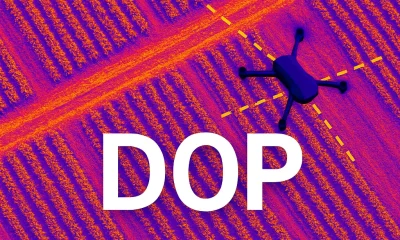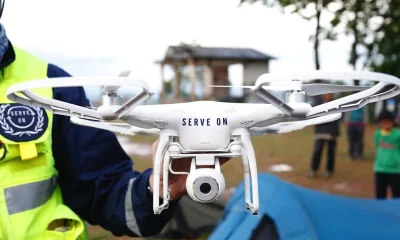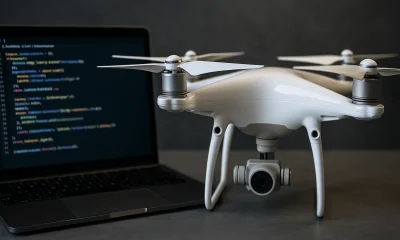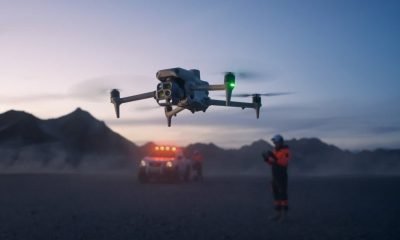- Acronym Guide
- AAM
- ABS
- AC
- ACAS
- ADS-B
- AEHF
- AFAC
- AGL
- AI
- AIM
- ALPA
- ALS
- AM
- AMA
- ANSI
- ANSP
- AOI
- APPI
- AUV
- AUVSI
- ARPAS-UK
- ASTM
- ATC
- ATO
- BLOS
- BVLOS
- CAA
- CAAC
- CAB
- CAP
- CASA
- CATT
- CBO
- CBR
- CBRN
- CDMA
- CDR
- CFI
- CFR
- CIR
- CISP
- CNP
- COA
- COMINT
- CORS
- COTP
- COTR
- CPTED
- CV
- C2
- DAA
- DAFI
- DAS
- DEM
- DFI
- DFS
- DGCA
- DHS
- DOD
- DOP
- DPA
- DPEs
- DRG
- DRI
- DRO
- DSM
- DSMX
- DSP
- DSSS
- DTM
- EASA
- EFB
- EFT
- EO
- EOD
- EO/IR
- ELINT
- EMI
- ESC
- EVLOS
- eVTOLs
- FAA
- FCC
- FCS
- FHSS
- FICCI
- FLIR
- FOB
- FOC
- FOV
- FPS
- FPV
- FRZ
- GBDAA
- GCP
- GCS
- GDPR
- GML
- GNSS
- GPS
- GSD
- GVC
- HDR
- HOGE
- IACRA
- ICAO
- ICS
- IED
- IMU
- INS
- IR
- ISA
- ISR
- ITU
- JARUS
- LAAMS
- LAANC
- LAATM
- LAI
- LAS
- LBA
- LIDAR
- LOA
- LOS
- LSALT
- MAC
- MAVLink
- MLIT
- MMS
- MSL
- MTOM
- NDAA
- NCSL
- NFZ
- NIST
- NMEA
- NOTAM
- NPA
- NPRM
- NTIA
- OBIA
- OEM
- OFDM
- OGI
- OOP
- OSD
- PAS
- PASM
- PAV
- PCV
- PdM
- PEC
- PIC
- PID
- PIPL
- PLD
- PM
- PN
- PPK
- PPS
- PSM
- PTZ
- PWM
- UAM
- UAOP
- UAS
- UASTM
- UAV
- UAVM
- UCAVs
- UHD
- UHF
- USV
- UTM
- RAIM
- RCC
- RCS
- RED
- ReOC
- RePL
- RFI
- RID
- RMS
- ROC
- ROI
- RPAS
- RPAAS
- RPC
- RTH
- RTN
- RTK
- SaR
- SAR
- SARP
- SBAS
- S.Bus
- SBIR
- SEDENA
- SfM
- SFOC
- SIGINT
- SLAM
- SMS
- SOP
- SOPMOD
- SORA
- STANAG
- STTR
- STK
- sUAS
- TCAS
- TCCA
- TFR
- TIN
- TLM
- TOF
- TP
- TPS
- TSA
- TSO
- TTP
- VHF
- VLOS
- VTOL
Drone Acronyms
What is UHF (Ultra High Frequency) & How Does it Work?
Published
3 months agoon
By
Jacob StonerTable Of Contents

Definition
Ultra High Frequency (UHF) refers to the segment of the radio spectrum ranging from 300 MHz to 3 GHz. This band supports a wide range of wireless communications and is commonly used in UAV (Unmanned Aerial Vehicle) operations for transmitting control signals, telemetry data, and live video. It offers an excellent balance between signal range and obstacle penetration, making it suitable for both direct and partially obstructed communication paths.
Usage
Drone operators often rely on this frequency band to maintain real-time links between UAVs and ground control stations. These links may include command-and-control transmissions, telemetry feedback, and video streaming. In long-range or BVLOS missions, the frequency’s stability and coverage make it a preferred choice. Some operations, particularly in defense or public safety, also use it for encrypted transmissions and communications in GPS-denied areas.
Relevance to the Industry
Reliable communication is critical for advanced drone missions. This frequency band is particularly valuable due to its resilience in various environments. It supports consistent data transfer across industrial sites, disaster zones, and rural regions. Additionally, frequency usage is subject to national regulation, which ensures that interference with public safety systems, broadcast channels, and aviation communication is minimized. Regulatory bodies issue licenses or restrict access depending on operational intent and bandwidth demand.
How UHF (Ultra High Frequency) Works
This frequency range enables drones and their ground stations to exchange wireless data using antennas and transceivers. The system supports telemetry transmission, control inputs, and video feeds over substantial distances. Here’s a breakdown of the process:
Signal Transmission Through Antennas
UAVs and ground stations use specialized antennas to send and receive modulated signals. These antennas may be directional or omni-directional, depending on the mission. They transmit essential data like aircraft position, health metrics, and control inputs.
Careful Channel Selection
Operators must choose frequencies that avoid interfering with nearby radio systems. Depending on location and mission type, they may use licensed channels or operate within unlicensed bands governed by industrial, scientific, and medical (ISM) guidelines.
Support for Line-of-Sight and BVLOS
While the frequency performs best in clear line-of-sight conditions, it can also penetrate light obstacles such as trees or buildings. For BVLOS operations, its stability helps maintain communication when GPS signals or optical tracking are unavailable.
Resilience and Interference Management
Unlike higher bands such as 5.8 GHz, this frequency experiences less attenuation from weather or foliage. It also supports technologies like frequency hopping or spread-spectrum to resist jamming and interference—crucial for tactical and rescue missions.
Regulatory Licensing and Safeguards
National telecom authorities often regulate its use. Operators may need to apply for access, especially when using high-powered transmitters or flying near sensitive zones. Non-compliance can result in legal penalties or operational shutdowns.
Failsafe Features and Redundancy
Many drones using this frequency include backup systems. If a connection drops, the UAV may return to home, enter loiter mode, or switch to a secondary communication link (e.g., LTE or satellite). These built-in protocols ensure continued control even in unexpected conditions.
By incorporating this technology, UAVs gain a reliable communication link that performs well across a wide range of missions—from infrastructure inspection and emergency response to defense applications and autonomous surveys.
Example in Use
“To support long-range BVLOS inspections, the drone used a licensed data link that operated in the UHF band assigned by the national telecom authority.”
Frequently Asked Questions about UHF (Ultra High Frequency)
Why do many drone systems use this frequency band?
It provides stable, long-range communication that isn’t easily disrupted by weather or terrain. That makes it ideal for UAV telemetry and control.
Can any drone operate on these frequencies?
Not always. In many countries, drone operators must obtain a license or authorization before using designated frequencies. Unauthorized use can interfere with protected systems.
Which types of drones benefit most?
Industrial UAVs inspecting pipelines, powerlines, or railways
Tactical drones with encrypted, mission-critical links
BVLOS drones needing dependable long-range control
Public safety systems operating in complex urban terrain
For examples of these acronyms visit our Industries page.
As the CEO of Flyeye.io, Jacob Stoner spearheads the company's operations with his extensive expertise in the drone industry. He is a licensed commercial drone operator in Canada, where he frequently conducts drone inspections. Jacob is a highly respected figure within his local drone community, where he indulges his passion for videography during his leisure time. Above all, Jacob's keen interest lies in the potential societal impact of drone technology advancements.
Pros
Cons
You may like


What is DOP (Dilution of Precision) & How Does it Work?


What is RPAAS (Remotely Piloted Aircraft as a Service)?


What is UAVM (UAV Middleware) & How Does it Work?


What is FOC (Full Operational Capability) & How Does it Work?


Mark Blanks – Head of Global Flight Operations at Wing


What is DRI (Detect and Recognize Identifier) & How Does it Work?